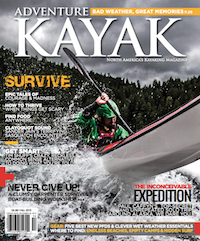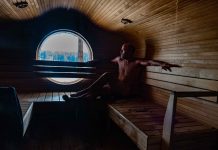My kayak is a survivor. She’s survived surf landings and seal launches; summers stored under blazing sun; cartwheels and preposterous payloads; countless rescues, demonstration and otherwise; pressures from the rat race; roadtrips to the country’s easternmost coast, and its westernmost.
Like an old friend, she has been at my side since I first discovered my calling in the cock- pit of a kayak. Perfect to me just as she is, I’ve ornamented and altered her very little. Today, she wears a deck compass on her bow. The spring she came into my life, I christened her Chiquita and for a time a blue-and-gold badge rode the waves with us. Then it washed away.
If memory is a strange thing, so is loyalty. Chiquita is not the fastest boat, nor the most capacious. There are kayaks that surf better, sprint quicker, cruise easier, carry more and, yes, even look prettier. But Chiquita is and does a bit of all those things—she’s never held me back. Maybe that’s what makes her a survivor.
In my profession, I can’t wear blinders. At kayaking events and in reviews for this magazine, temptation taunts me with scores of graceful bows, glitzy colors and cozy cockpits. For a time, I entertained a dalliance with a robin’s egg-blue Pilgrim Expedition — think of the places we could go! More recently, I fell for a hot pink, rocket-fast Stellar S14S surf ski —it’s not cheating if it’s a ‘ski, right?
The only crush I never quite got over was the Pygmy Murrelet I borrowed from Dan Jones in the fall of 2012. Patiently hand-built by its owner, the Murrelet’s mahogany deck gleamed with an inner luster, and its multi-chine hull parried every challenge I could muster with grace and alacrity. I returned the boat reluctantly.
Over the years, Chiquita’s rotomolded yellow plastic has faded just a little, and her hull bears the scrapes and gouges of many a cobble beach and unseen shoal, including that mussel-encrusted rock that hides beneath the wave at Surge Narrows. But the plastic has never oil-canned, the welded bulkheads and lovingly 303-protected rubber hatches have never leaked. The foam seat now appears as if chipmunks have mistaken it for an acorn, yet it’s cradled me through hundreds of rolls and along thousands of kilometers of coast.

Perhaps loyalty is simply a nostalgic and hopeful elixir of shared experience and tantalizing promise. Going on a paddling trip without Chiquita feels like leaving a trusted friend behind. I imagine if I did so permanently, the remorse would approach something akin to survivor’s guilt.
Still, when I had the opportunity to join Jones’ boat-building workshop and craft my own Murrelet, I couldn’t pass it up. For a blissful week of building, I thought only of the new boat taking shape in my hands. Then I brought the partially finished shell home and lay it in the basement beside Chiquita. Guilt and a hint of doubt needled at my excitement.
I placed a hand on Chiquita, suspended in her place of honor on the wall. She felt cool and smooth. Capable. I thought of my brother, who parks his first car—an ’85 Pontiac Bonneville four- door that once belonged to our grandmother—in the garage under carefully draped quilts, while his new Jeep collects pollen and bird droppings in the driveway. I contemplated my canoe-crazed friend who builds and paddles the most beautiful cedar- canvas boats, but scoured the classifieds until he found and bought an exact twin of the first plastic Royalex canoe he ever owned.
“Don’t worry, Chiquita,” I softly reassured the yellow kayak, “you’re staying right here.”
Send your own survivor stories to Virginia Marshall at editor@adventurekayakmag.com.

Subscribe to Paddling Magazine and get 25 years of digital magazine archives including our legacy titles: Rapid, Adventure Kayak and Canoeroots.








